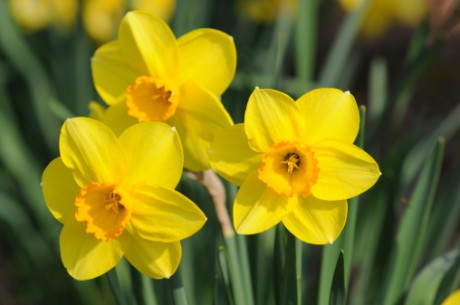Spring Into Action
Spring gardening tips from the Carolina Country archives

Garden vegetables and fruits
- Cool-weather vegetable crops now being harvested should be followed by plantings of warm-weather ones like snap beans, squash, green beans, lima beans, okra, lettuce, tomatoes and beets.
- When setting tomato and green pepper plants, place collars around the bases to protect from cutworms. Plastic cups with bottoms removed make good collars.
- Stake tall-growing tomato plants, or place wire cages over them. As plants grow, secure them to the support with strips of sturdy cloth or discarded pantyhose.
- Vegetables can be used as part of the flower garden. For example, carrots to edge a flowerbed (the foliage gives a fern-like edging); strawberries as a low-edging plant or groundcover; cabbages backed with zinnias, with petunias in front.
- Plant green beans, cucumbers, squash and other warm season vegetables.
- Remove blooms from herbs to direct plant energy to produce foliage, not flowers.
Trees and shrubs
- The first spring is a critical time for newly-planted shrubs and trees. Water them deeply once or twice a week during dry periods.
- Most shrubs respond well to a general feeding of ¼- to ½-pound balanced plant food per square yard of area covered by plant. Do not permit fertilizer to touch stems or leaves. Distribute fertilizer evenly. If there is heavy mulch, or soil is badly packed, cultivate well. Water fertilizer into soil.
- Remove faded blooms when they appear on bedding plants and shrubs.
- Dig and transplant small seedlings of nandinas that have grown up under established plants. If established plants have grown tall and scraggly, cut away older, thicker stems at ground level.
Flowers
- When Easter lilies are in bloom, pluck the stamens to remove yellow pollen as soon as it is visible. This prevents ripening pollen from discoloring petals, making flowers last longer.
- Even shady spots can contribute summer color from annuals. The following endure somewhat heavy shade: petunia, balsam, calliopsis, godetia, lobelia, cockscomb, flowering tobacco, periwinkle and impatiens.
- Good bedding plants for bright sunny spots: portulaca, zinnia, marigold, salvia and celosia. Make massed plantings of zinnias, marigolds and petunias. These most popular of annuals contribute summer-long color accents.
- Plant an evergreen vine such as English ivy or Carolina jasmine along with clematis vine. This provides a green camouflage when clematis is bare of leaves in winter.
- As blooms fade, cut daffodils, tulips and hyacinths if not done earlier. Since foliage is manufacturing food for next year's growth, let it remain until leaves mature and turn brown or yellow.
- If daffodils multiply and become crowded clumps that produce little to no blooms, lift, divide and replant.
Lawn
- Apply lawn-weed prevention to keep crabgrass seeds from sprouting and becoming summer weeds.
- If large trees cast shade on the lawn and the shaded area is not planted with a groundcover, apply a complete fertilizer such as 6-12-12, 5-10-5, 8-8-8, or 12-6-6 at a rate of 30 to 35 pounds per 1,000 square feet. This relieves competition of trees and lawn grasses for nutrients.
- Fertilize summer grasses such as Zoysia, Bermuda and Centipede. Do not fertilize fescue until fall.
- Start groundcovers of liriope, Mondo grass and English ivy where grass refuses to grow.
Treatments
- Five tablespoons of bleach in a gallon of water, shaken well, will help prolong the life of cut flowers. Keep the vase full of solution.
- To attract hummingbirds, bees, and butterflies, include bee balm in flowerbeds.
- Fertilize azaleas with special azalea and camellia food, or use a balanced fertilizer like 8-8-8 or 10-10-10.
- Among good mulches for plants: pine needles, oak leaves, old sawdust, cotton and peanut hulls, shredded bark and bark chips, and peat moss that has been soaked in water for several hours.
One last tip
- If you enjoy feeding birds in winter, then plant a row of sunflowers in the back or side of your garden. These tall-growing annuals produce enormous heads of rich, oily seeds. In late summer when flowers have matured, cut and dry them. Next winter, these seed-studded disks will be a true delicacy for birds.
-
Share this story:


